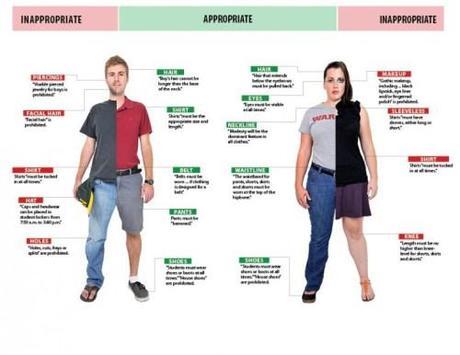
Image from dailytimes.com
The fashion police have been cracking the whip in schools across America. Even though school’s out for the summer, debate still rages on regarding controversial changes to many dress codes. Middle school girls in Evanston, Illinois protested a ban on leggings by wearing them anyways. They also gathered more than 500 signatures on a petition objecting to the ban. Some schools have put restrictions on the types of dresses appropriate for prom, including banning dresses with low-dipping backs or thigh-bearing slits. The dress code bans are more than just restrictions regarding sartorial choices. They reflect a harmful culture which polices girl’s bodies and shames them for their sexuality.
The rationale for the banning of clothing such as yoga pants is it “disrupts the learning process.” The implied and sometimes directly stated end of this sentence is the girls are distracting the boys with their “inappropriate” clothing choices. This is both harmful to girls and highly offensive to boys. It implies that boys are unable of normal cognitive functioning and learning in the presence of a girl wearing an attractive outfit. If boy’s ability to add sums is derailed by the presence of a yoga-pants clad female, this should be the problem of said male. Instead, girls are blamed. This reflects a disheartening lack of belief in the male gender. All adolescent boys are not the uncontrollable lust-driven degenerates as we sometimes make them out to be. All adolescent boys are not distracted by yoga-pants and leggings. The clothing choices of girls should not be controlled by the possible distraction said choices could pose for a few boys. Instead of asking these select few boys to simply focus or perhaps wear blindfolds, the ban on “distracting clothing” promotes the tautology “Boys will be boys.” Boys are not viewed as the problem, as they are simply “boys,” inherently lustful and unchangeable in that regard. But girls, girl’s bodies can be policed. And so girls become the problem and the solution.
The rationale for dress codes or uniforms at some schools is not the male gaze, but the desire to maintain a classy school image. This is especially true for many private and parochial schools. The basic underlying assumption behind all of this is that clothing has a correlation to behavior. Crisp white polos and khaki pants corresponds to those well-mannered and well-behaved, while plunging necklines and short skirts corresponds to reckless and promiscuous behavior. Schools obviously want their students to at least outwardly appear to be well-mannered and well-educated, and so they clad their students in polos and khakis. They steer clear of the negative connotations associated with the miniskirt by banning it, and its entire ilk. In controlling the clothing options of the students, the school can in turn control its own image. The school gains control, but the students and especially the girls lose it.
Policing girl’s bodies by shaming “inappropriate” clothing takes away their power. They no longer have control over their own body, or the way they dress it. Regardless of what they might want to wear, other people dictate their choices. This does not empower girls, but represses them and their sexuality. It teaches females there is something inherently wrong or shameful about certain body parts like the thigh or breast. Those are the body parts that need to be hidden. The dress code bans also disproportionately affect more well-developed girls. A certain top may be acceptable on one girl but scandalous on another with a different build. This unfairly targets and shames some students for their body type. Most dress code bans include numerous items limiting girl’s sartorial choices, but few items limiting those of males. The sexist policies imply there are many ways that girl’s bodies can be shameful, while very few ways boys can be. Some would argue the expression of sexuality in girls should be banned and shamed. Others believe in a healthy sense of sexuality, but oppose to self-objectification.
Some argue that banning “inappropriate” clothing is one way to stop girls from self-objectifying. I believe objectification is harmful but certainly not inevitable. This is not to deny that the hyper-sexualization in the media can teach young girls that their only value comes from their looks–that good looks and “sexy” clothing are essential keys to desirability. Unfortunately, girls are given very narrow archetypes of beauty and what is beautiful. This indoctrination can prompt some girls to attempt to conform to the ridiculous standards in a hurtful cycle of self-objectification: girls see themselves as objects. Self-objectification is certainly damaging to girls, but there are truly many empowered girls who wear miniskirts or mascara simply because they like it—not because they fell they have to, or feel pressure to do so in order to be “beautiful.” Why should we stop them from wearing what they want? Adolescence is about experimentation and discovery of likes and dislikes, including self-expression and sartorial choices. Girls are learning about and exploring their sexuality, and they should be free to do so; free to express themselves without being told certain ways of expression are wrong and others right. It is possible for girls to be comfortable with their bodies and with their sexuality. Banning yoga pants or short skirts is not the way to remedy the epidemic of low self-esteem. What is?
A school in San Francisco seems to have a pretty decent answer. This school has plans to teach students, both boys and girls, about the malignant effects of sexualization. Teaching students about the harmful, often unnoticed and unscrutinized media influences helps them to fight back. Just the awareness that beauty standards are arbitrary and ridiculous can help both boys and girls not to care about them. Rejecting typical archetypes or definitions of beauty fosters self- confidence and lowers self-objectification. The road to body-image confidence and self-esteem is difficult enough with deleterious influences from the media, and restrictive dress codes make the path even more difficult. Here’s to the destruction of the fashion police.

